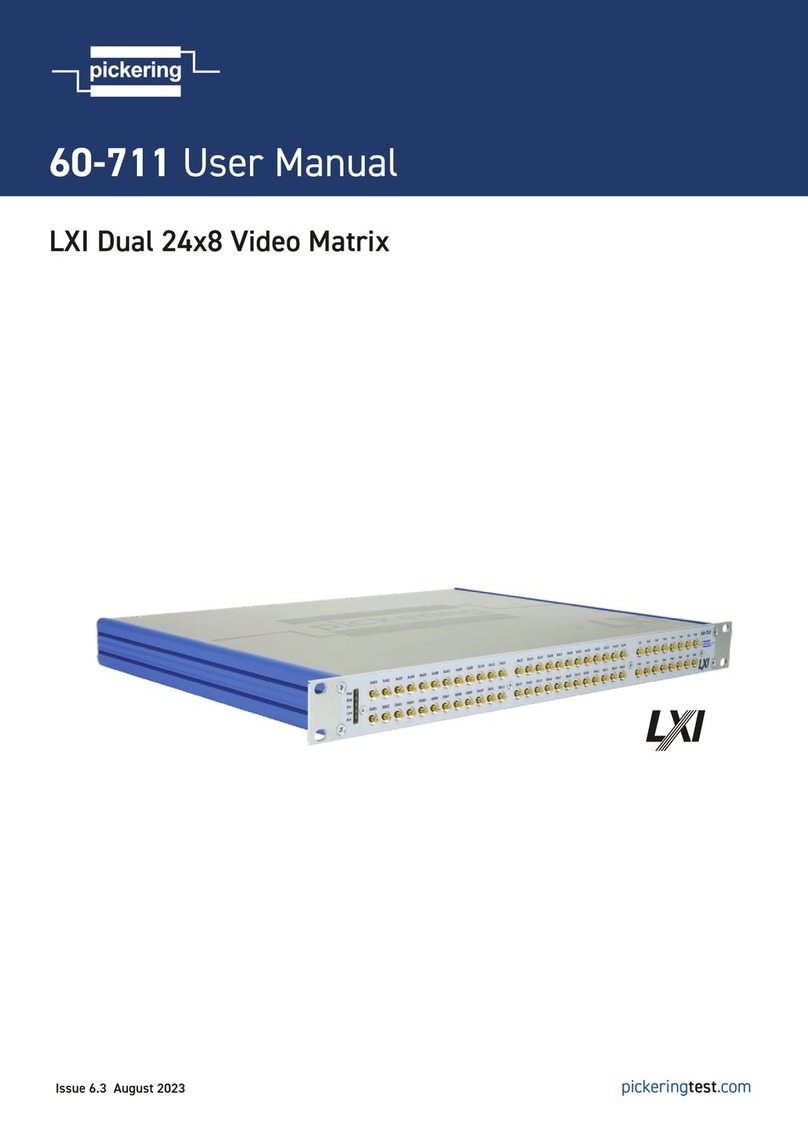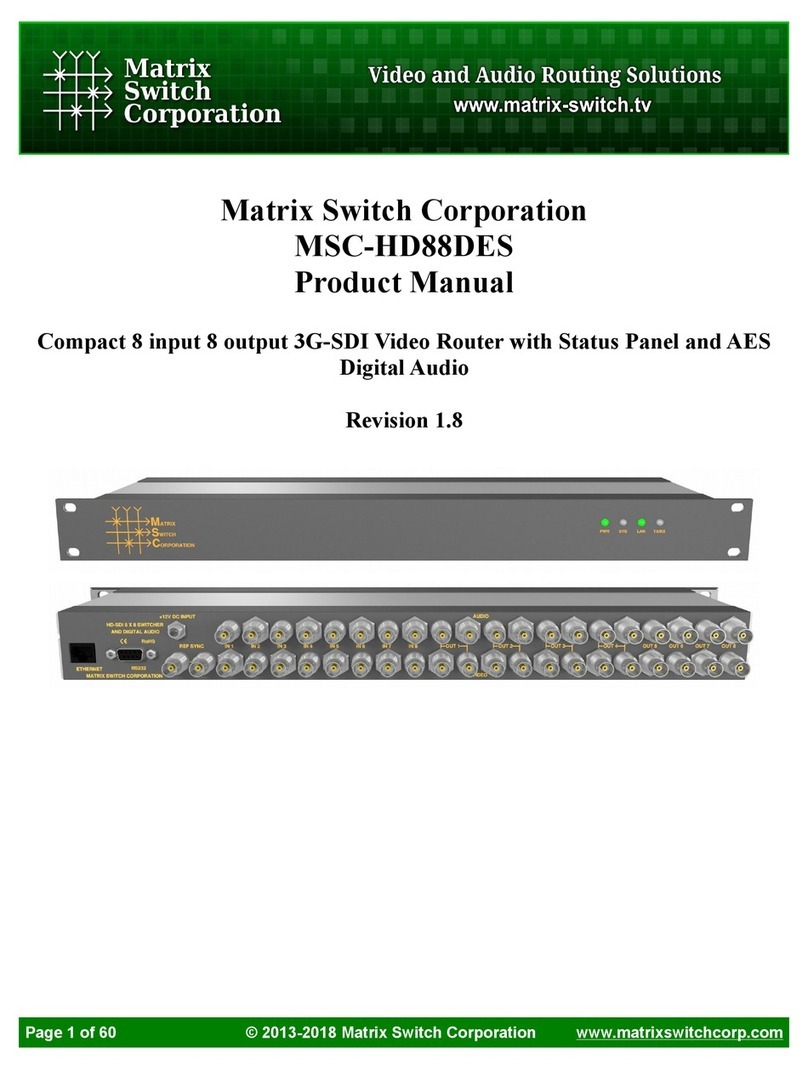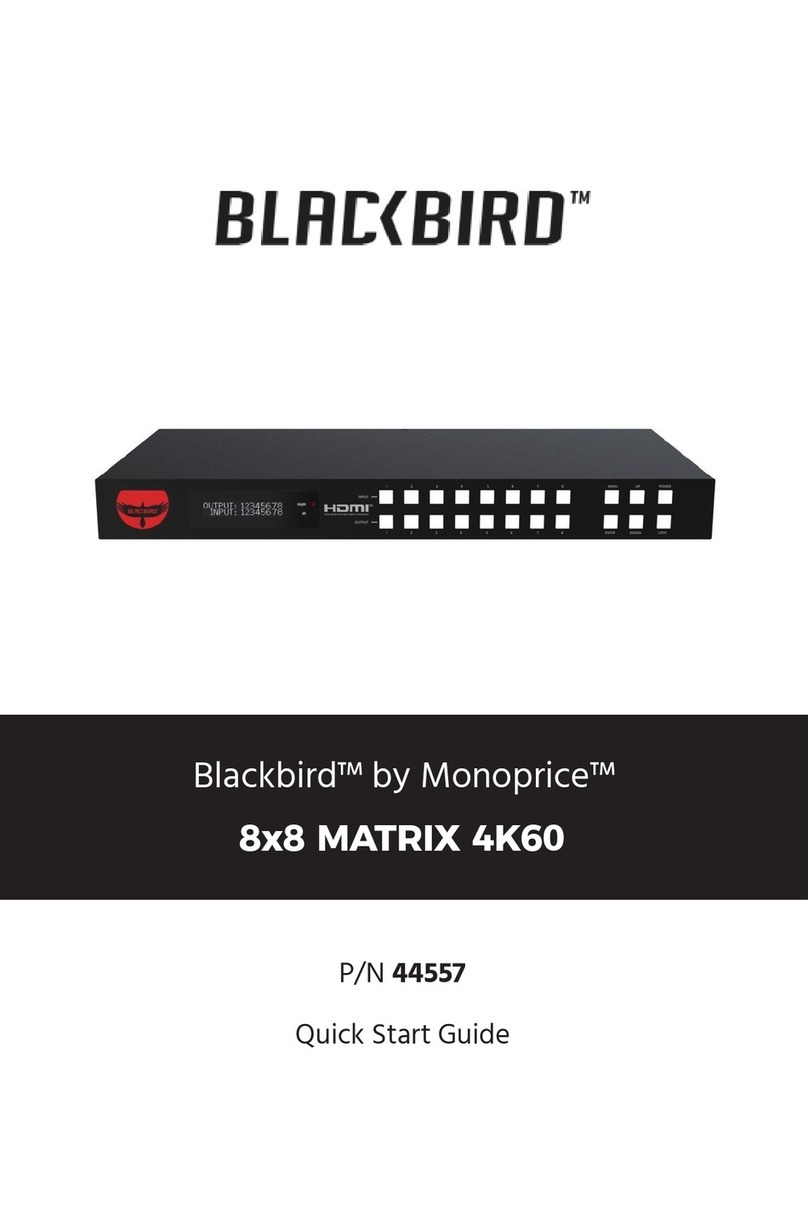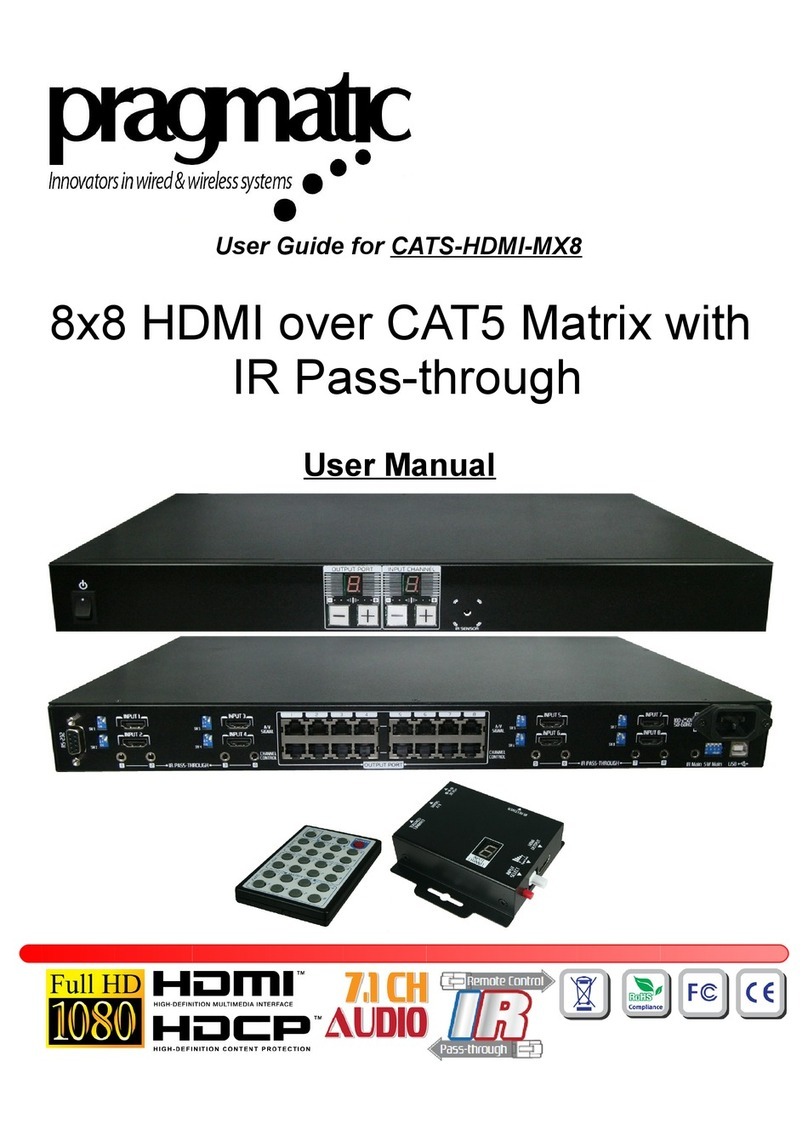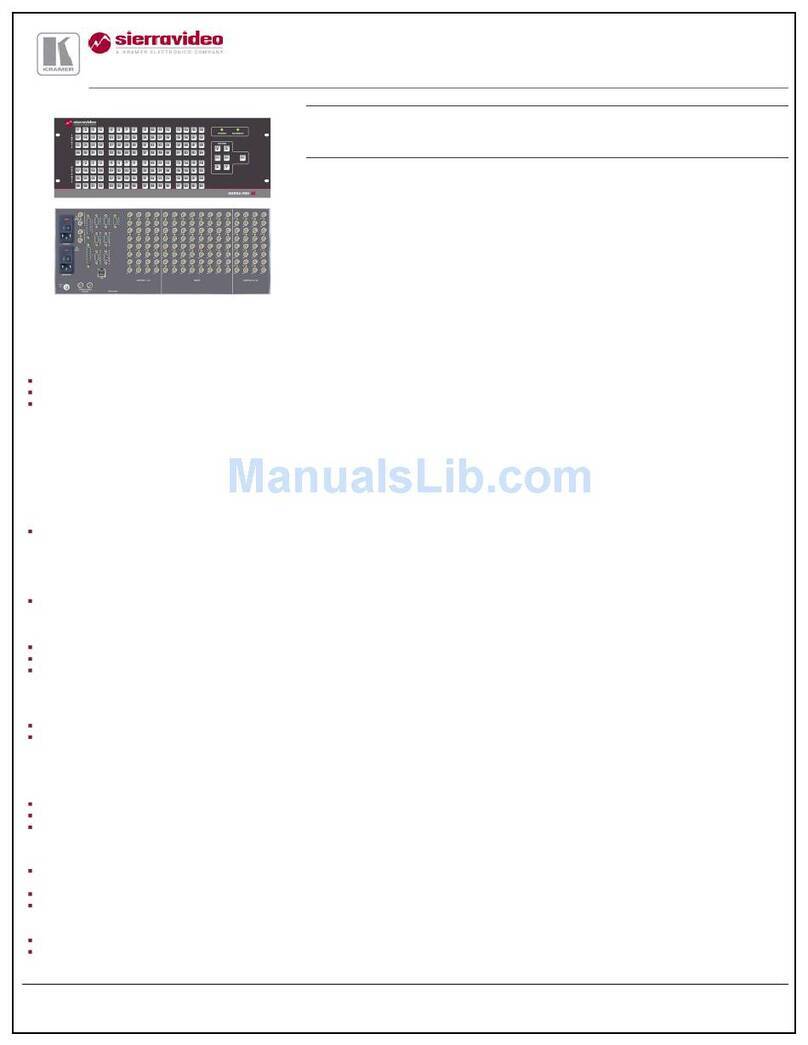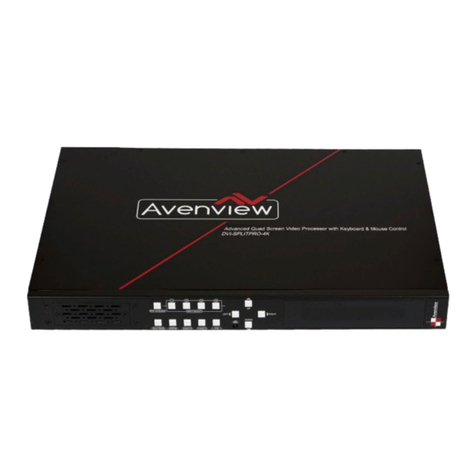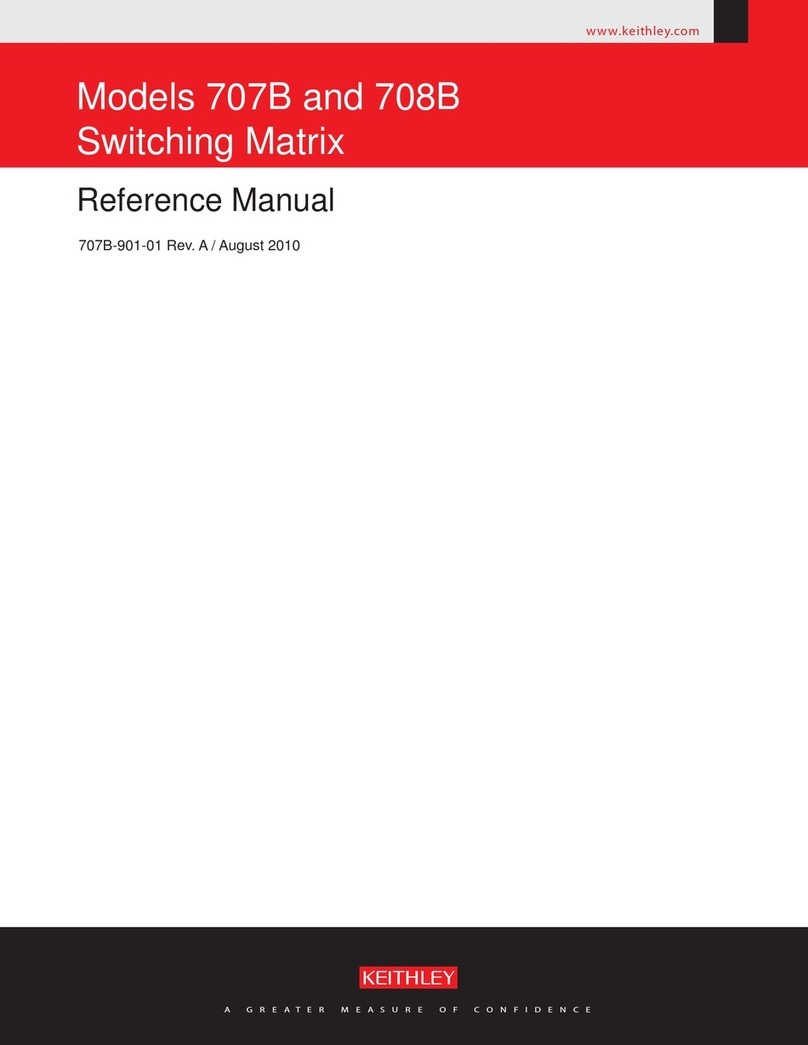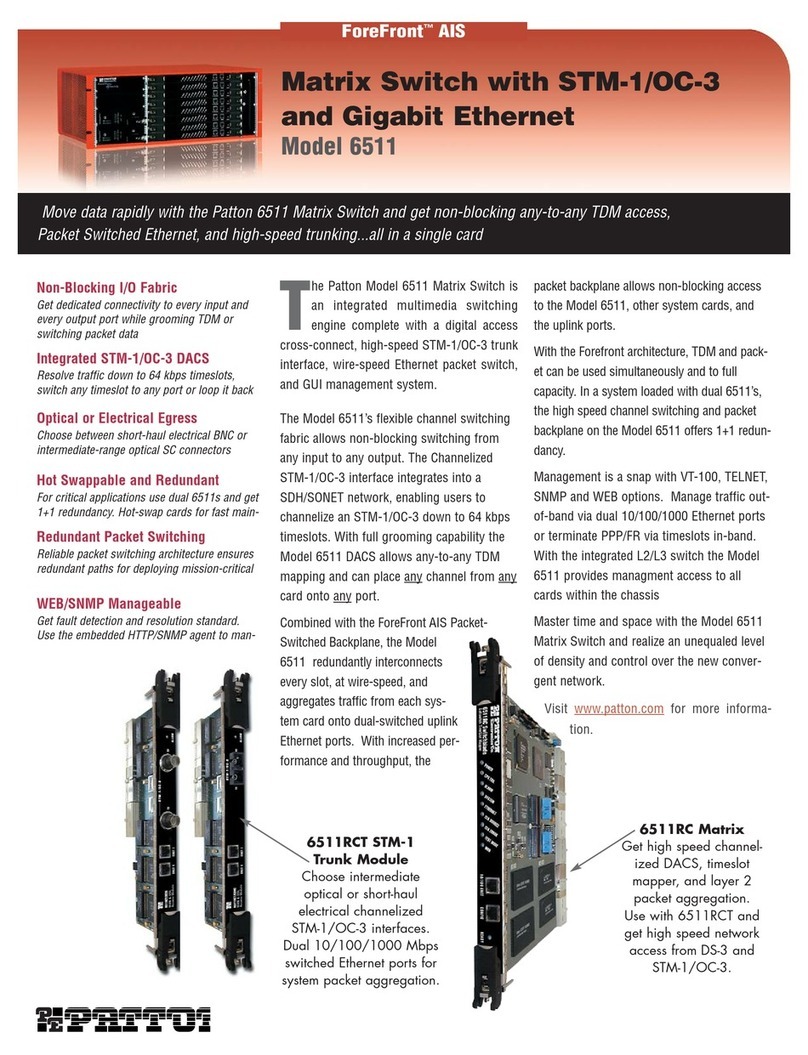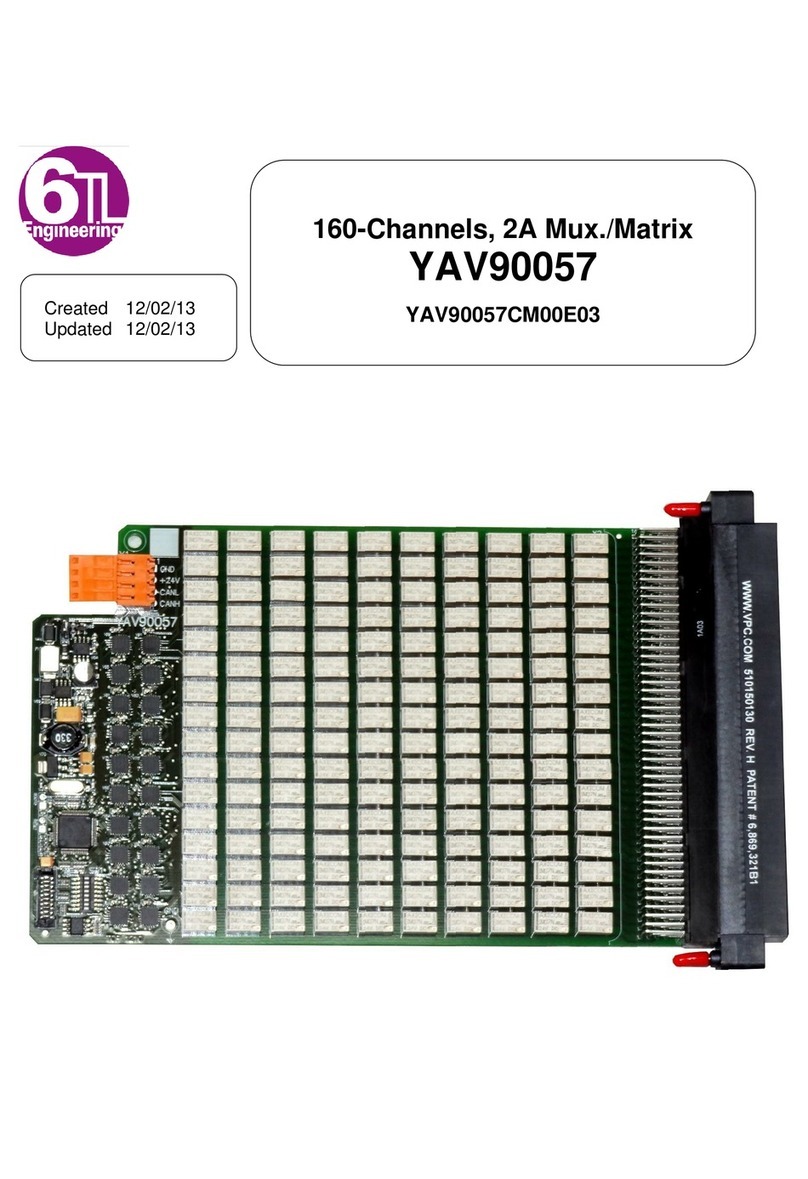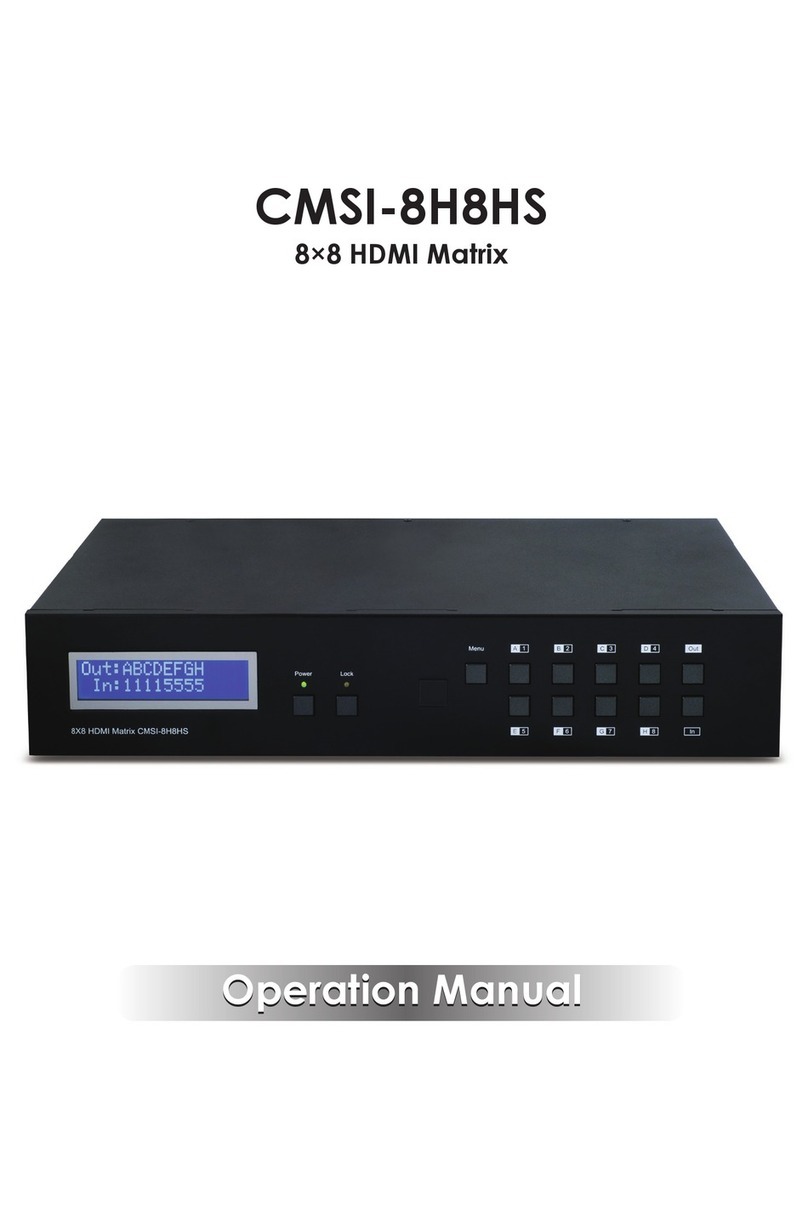HDTV Supply HDTV88CAT User manual

8x8 HDMI Matrix
with Simultaneous CAT and HDMI Outputs
Operation Manual
VER:1.2

User Manual
Page 1 of 16
1.
Introduction
The 8x8 HDMI Matrix with simultaneous CAT and HDMI outputs connects eight
HDMI sources to ten displays. The matrix features eight CAT -Cable outputs and
output 7&8 are mirrored to provide a HDMI output which runs simultaneously .
Connect a SINGEL UTP Receiver to each of the CAT -Cable outputs to extend the
HDMI signal up to 164ft/50m for multi-room connectivity. It works with Blu-Ray
players, Set-Top boxes, Home Theater PCs, and game consoles that connect to
an HDMI display. Any source is accessible at all times by any display by selecting
it via the supplied IR Remote Control, RS -232, TCP/IP or by using the selection
buttons on the front panel. This device supp orts High Definition Audio, and 3D
signal compatibility.
2.
Features
HDMI1.3, HDCP 1.1 and DVI1.0 compliant.
Supports HDMI 3D pass -through.
Supports resolutions from VG A~WUXGA and HD resolutions from
480i~1080p dependent upon the EDID settings.
Supports transmission distances up to 164ft/50m through CAT5e/6/7 cable.
Supports simultaneous HDMI and CAT outputs.
Supports wideband IR(20-60Khz) matrix system, IR transport cha nnel can be
forward or backward.
Supports RS-232, remote control, on -panel control and TCP/IP Control.
Supports smart EDID management.
Supports LPCM 7.1CH, Dolby True HD, Dolby Digital Plus and DTS -HD Master
Audio transmission.
3.
Package
Contents
8x8 HDMI over CAT Matrix 1pcs
SINGEL UTP Receiver 8pcs
12V/5A DC power adaptor 1pcs
5V/1A DC power adaptor 8pcs
Operation Manual 1pcs

User Manual
Page 2 of 16
Wideband IR Tx cable 8pcs
Wideband IR Rx cable 9pcs
HDMI Matrix IR Remote 1pcs
Mounting ears(Matrix) 2pcs
Mounting ears(Receiver)
16pc
s
RS232 cable 1pcs
4.
Specifications
Video Bandwidth
165 MHz
Support Video Resolution 480i,576i,480p,576p,720p,1080i,
1080p24/30/50/60.
Input Ports
8×HDMI, 8×IR Extender, 1×RS
-232,
1×RJ-45(Control) , 1xMatrix IR Extender
Output Ports
8×CAT, 8×IR Extender,
2×HDMI , 8×Audio
ES D Protection Human -body Model:
±
8kV (Air -gap discharge)
±
4kV (Contact discharge)
Power Supply 12 V/5 A DC (US/EU standards,
CE/FCC/UL certified)
Dimensions
440 mm (W)×2 00 mm (D)× 45 mm (H)
Weight
182 0 g
Chas sis Material
Metal
Silkscreen Color
Black
Operating Temperature 0 ºC~40 ºC/32 ºF~104 ºF
Storage Temperature −20 ºC~60 ºC/−4 ºF~140 ºF
Relative Humidity
20~90 % RH (non-condensing)
P
ower
C
on
s
ump
ti
on
60
W
(
m
ax
)
/
0.5
W
(
S
t
a
ndb
y)

Page 3 of 16
User Manual
5.
PANELFUNCTIONS
5.1 Front Panel
1.
LCM
LCM: Displays the information of each input and output setting and EDID
management.
2.
I
R
\
P
OWE
R
\
L
O
C
K
IR: IR Receiver window (accepts the remote control signal of this device
only).
POWER: Press this button to power the device on/off. The LED will
illuminate green when the power is on, red when it is in 'Standby' mode.
LOCK
:
Press this button to lock all the buttons on the panel, press again to
unlock.
3.
OUTPUT/INPUT
OUTPUT/INPUT
: Press the OUTPUT and INPUT button to select the output
corresponding input.
※
For example:
Press OUPUT ALL >INPUT
1, The OUTPUT A -H will be set to INPUT 1.
Press PTP button, The OUTPUT
A-H will corresponding INPUT 1 -8.
4.
EDID :
Smart EDID management, the LCM will display the EDID operation.
Press the MENU button will enter t
he EDID management window,
Press UP or DOWN butt on to select the needed EDID se tting,
Press ENTER button to s elect the download input source
,
it can easy download any EDID mode to any input source.
A
B
C
D
OUTPUT
E
F
G
H
ALL
EDID
MENU UP
1
2
3
4
5
6
7
8
PTP
EN TE R DO W N
INPU T
3
4
O U
T
P U
T
: A B C D E F G H
I N P U
T
: 1
2 3 4 56 7 8
MATRIX 8X8
1
2
2
A
B
C
D
OUTPUT
E
F
G
H
ALL
3
1
2
3
4
5
6
7
8
PTP
INPU T
EDID
MENU UP
4
EN TE R DO W N

Page 4 of 16
User Manual
※
Note:The EDID mode
table
EDID Mode
EDID Description
1
1080 i, 2CH AUDIO
2
1080 i, DOLBY/DTS 5.1
3
1080 i, HD AUDIO
4
1080 p, 2CH AUDIO
5
1080 p, DOLBY/DTS 5.1
6
1080 p, HD AUDIO
7
3D,1080p, 2CH AUDIO
8
3D, 1080p,DOLBY/DTS 5.1
9
3D,1080p, HD AUDIO
10
4k x 2k , 2CH AUDIO
11
4k x 2k , DOLBY/DTS 5.1
12
4k x 2k , HD AUDIO
13
DVI 1024x768
14
DVI 1920X1080
15
DVI 1920X1 200
16
Copy from HDMI OUTPUT
G
17
Copy from HDMI OUTPUT
H
EDID. What is it and what is it used for?
Under normal circumstances, a source device (digital and analog) will require
information about a connected device/display to assess what resolutions and
features are available. The source can then cater its output to send only
resolutions and features that are compatible with the attached device/display.
This information is called EDID (Extended Display Information Data)
and a source device can only accept and read one EDID from a connected
device/display. Likewise, the source an only output one resolution for use by a
connected device/display.

Page 5 of 16
User Manual
Why is EDID so important with theHDMI Matrix?
The Matrix is complex piece of technology that replicates and switches between
multiple inputs and outputs. Each connected source device will require one EDID
to read. EDID management is carefully handled by HDMI Matrix to provide a
single EDID for each source to read.
What options do I have to manage the EDID in the HDMI Matrix?
First, it is important to note that each source device can only output one
video/audio signal type. This includes resolutions and timings. When multiple
devices/displays are used, such as with the HDMI Matrix, it is important to use
devices/displays that have similar or compatible resolutions/features. This will
ensure that the single video/audio signal produced by the source device is
accepted by all of the connected output devices/displays. The user has the
option, through the EDID management window, to choose how the unit will
manage the EDID from multiple HDMI devices/displays. Therefore the user has
some control over the resolutions/features that the source devices will output.
The HDMI Matrix for has a multiple EDID management modes that will control
how the EDID information from multiple devices/displays are combined, ignored,
and routed.
5. 2 Rear Panel
1.
PC CONTROL
T
C
P
/
I
P
:
T
hi
s
p
or
t
i
s
th
e
li
n
k
f
o
r
T
C
P
/IP
co
n
t
r
ol
s,
c
onnect
to
an
acti
v
e
E
ther
n
e
t
link with an RJ45 terminated cable.
RS232: Connect to a PC or control system with D-Sub 9-pin cable for the
transmission of RS-232 commands.
1
AUDIO OUT
OUT 1 OUT 2 OUT 3 OU T 4 OUT 5 O UT 6 OUT 7 OUT 8
2
OUT A
OUTPUT
OUT B
OUT C
OUT D
OUT E
OUT F
OUT G
OUT H
POWER
DC 12V
INPU T
IN 1 IN 2 IN 3 IN 4
3
4
5
IN 5 IN 6
6
4
IN 7
IN 8
HDMI OUT G
HDMI OUT H
1
2
7
8
G
H
5
3
6
1
3
4
INPU T
IN 1 IN 2 IN 3 IN 4 IN 5 IN 6 IN 7 IN 8
1
2
3
4
5
6
7
8
AUDIO OUT
OUT 1 OUT 2 OUT 3 OU T 4 OUT 5 O UT 6 OUT 7 OUT 8
2
OUT A
OUT B
OUT C
OUT D
OUTPUT
OUT E OUT F
OUT G
OUT H
HDMI OUT G
HDMI OUT H
G
H
5
6
POWER
DC 12V

Page 6 of 16
User Manual
2.
Audio out
1) Analog audio output, Audio Extraction from HDMI input signal and support
PCM 44.1K,48K,96K
3.
IR Channel
IR EXT: if the panel sensor is obstructed or the unit is installed in a closed
area out of infrared line of sight, the IR RX receiver included can be inserted
into the IR EXT port at the rear to extend the IR sensor range and enable
local control of the matrix.
IR IN/OUT:
Super IR control system interface. for further details, please refer
to the Super IR system control introduction.
4.
HDMI INPUT
Connect to the HDMI input source devices such as a DVD player or a Set-top
Box with HDMI cable.
5.
HDMI and CAT OUTPUT
The HDMI OUTPUT connects to HDMI equipped TVs or monitors and the CAT
OUTPUT connect to the SINGEL UTP Receiver.
6.
DC POWER IN
Plug the 12V/5A DC power supply into the unit and connect the adaptor to
an AC outlet.
6. Remote Control
P
ower
on
/
S
t
a
ndby
:
Pr
e
ss
thi
s
bu
t
ton
f
o
r
power
on
the matrix or set it to standby mode.
1.
Input port selection area
:Press these buttons
to select input 1-8. Press forward/backward button
will cycle from input 1-8.
2.
Output port selection area
:Press these buttons
to select output A-H, including ALL.
How to operatethe Matrix Remote?
1.
Power on and standby
Q.
How to power on and standby?
A.
P
r
e
ss
P
ower
on
/
S
t
an
dby
b
ut
ton
and
w
a
i
t
a
whi
l
e.
1
Input
1 2 3
2
4
5 6 7 8
Output
A B C
3
D
E F G H
All
HDMI Matrix Remote

Page 7 of 16
User Manual
2.
How to select Output and Input Port?
Q.
OUTPUT-X select INPUT-Y:
A.
Press OUTPUT-X (X means 1 to 8 of outputs, including ALL)Press INPUT-Y
(Y means 1 to 8 of inputs)
7.
Super
IR
Control
system
(IR Call-back of Matrix and Source Devices)
The matrix is not only a switcher and
extender of multiple HDMI signals to
multiple HDMI receivers located
remotely, it also passes IR control
signals through the IR call-back
system to the matrix and HDMI
sources for full, independent control
of all connected inputs from output
locations.
Two-way IR Call-back Between
matrix, Sources and Displays from
Multiple Locations
A key feature on the matrix is
discrete IR control of the matrix,
sources and displays from any
location – so inputs at the matrix
end can be controlled at a display
location and displays can be
controlled at the matrix location.
This is accomplished by placing a
series of IR Emitters on devices to control and IR Receivers at all locations you
wish to control from to enable the IR signal to travel both ways via the single
Cat5e/6/7 cable.

Page 8 of 16
User Manual
1.
At Matrix end: Insert the 3.5mm jacks of the IR TX Emitters included with the
unit into the IR TX Emitter ports at the rear of the matrix according to input. The
IR signal is added to the HDMI of the input device so, for example, if the user is
watching Blu-ray on input 1, the IR signal will be directed through the IR TX1
socket to control the device.
As each IR TX port is allocated to an individual HDMI input port, if the user is
unable to establish IR control of the device, care should be taken to check firstly,
that the IR emitter and HDMI input ports match (Input 1-TX1, Input2-TX2 etc.)
with plugs secured in correct ports, and secondly, that the IR TX emitter sensors
are firmly attached directly to the front of inputs and covering infrared sensor
windows of the source devices. Some later adjustment may be needed to the
location of the sensor to achieve the best performance results - sometimes
moving the sensor to different areas on the source can improve IR performance.
NOTE: Infrared receiving areas of devices can be located by s hining a flashlight
onto the front of the device – the sensor should be able to be seen through the
plastic as a small, round object inside. Insert 3.5mm jacks of IR RX receivers into
RX ports, making sure the receivers themselves are placed in clear view to
receive an infrared signal from the remote handset used to control the display
outputs.
2.
At display end: Insert the IR RX Receiver jack into the IR RX po rt of the
display receiver, with the receivers themselves placed in clear view on or near
the displays to receive an infrared signal from the remote handset used to
control inputs. Insert the IR TX Emitter jack into the IR TX port of the display
receiver, ensuring that the emitter sensor is securely attached to infrared sensor
window of the display. Follow the same connection and positioning for all
baluns/displays connected to the matrix. If all IR TX Emitters and IR RX Receivers
are positioned and connected correctly with sources, displays and display
3

Page 9 of 16
User Manual
receivers fully powered and the matrix set to IR call-back enabled and IR TX
Swicth mode activated, two -way IR will now be possible.
Note: Misplaced or poorly secured IR Emitters and Receivers may result in
intermittent IR control signals passed to and from the matrix. Check your
placement and adjust if necessary.
ADVANCED OPERATION
Typically, unless alternative methods of controlling the matrix are chosen or
problems with device communication through the matrix encountered, basic
operation is all that is required to operate your matrix. However, the following
information on advanced operation will detail how the matrix system can be
configured and for advanced control and settings can be altered or data
manually input should such problems arise, as well as configuring the system for
third party control.
8. SINGEL UTP Receiver
1
2
3
4
5
6
67
678
6789

User Manual
Page 10 of 16
1.
HDMI OUT: This slot is where you connect the HDTV or monitor with HDMI
cable for input source display.
2.
LOCK LED:
This blue LED illuminate when the signal locked.
3.
POWER LED:
This blue LED illuminate when the device is connected with
power supply.
4.
Coaxial OUT: This slot is where you connect to the amplifier with coaxial
cable.
5.
ARC SW:
Switch this SW to open or close the ARC function.
6.
DC 5V:
Plug the 5V DC power supply into the unit and connect the adaptor
to AC wall outlet.
7.
IR RX:
This 3.5mm phone for super IR control system IR receiver .
8.
IR TX:
This 3.5mm phone for super IR control system IR Emitter.
9.
C
A
T
5
E
/
6
:
T
h
i
s
C
A
T
5
E
/
6
po
r
t
c
onnect
t
o
HDMI
Ma
t
r
i
x
C
A
T
O
U
T
PU
T
w
ith
CAT5e/6/7 cable.
AUDIO RETURN CHANNEL (ARC)
The connected display must support this function for ARC to function correctly.
When ARC is activated, the Coaxial output of the receiver unit will output the
display’s content audio signal. When ARC is de-activated, the Coaxial output of
the receiver unit will output the source’s audio signal.
IR
IR BLASTER (TX)
To control the source: Plug IR Blaster into IR TX port of transmitter unit; place
blaster in front of the IR eye of the source.
To control the display: Plug IR Blaster into IR TX port of receiver unit; place
blaster in front of the IR eye of the display.
IR RECEIVER (RX)
To control the source: Plug IR Receiver into IR RX port of receiver unit; place
receiver at or near display.
To control the display: Plug IR Receiver into IR RX port of transmitter unit; place
receiver in position where it is able to receive remote signals.

User Manual
Page 11 of 16
IR RECEIVER
IR RLASTER
9.
PC controller user guide
Installation
Matrix controller is a green software. Just copy MatrixController.exe to PC which
is used to control the Matrix by RS232 COM port or TCP/IP to complete
installation.
Preparation
Connect PC and Matrix by RS232 cable (headers of both sides of cable
should be FEMALE) or TCP/IP(local area network)
Power-up Matrix
Double click MatirxController.exe icon to run it

User Manual
Page 12 of 16
How to control Matrix
“General” page
1.
Select RS232 COM or TCP mode
2.
Select RS232 COM port
3.
Click to connect or disconnect PC and Matrix
4.
Select Matrix IP
5.
Connect to Matrix IP
6.
Search Matrix IP
7.
Configure Matrix IP and MAC
8.
Click to reset to the factory settings
9.
Device information display area
1
2
3
9
4
5
6
7
10
11
8
12

User Manual
Page 13 of 16
10.
Click to refresh device status: include device information displayed in
9
area
and Input/Output Settings on “Matrix” page
11.
Click to clear device information
12.
Enable or disable Beep
Configure TCP
After action of 7, edit form will pop-up as below:
1.
Select auto or static IP
2.
Rewrite the Matrix IP
3.
Rewrite the Matrix MAC
“EDID control” page
1
2
3
1
2
3
4

User Manual
Page 14 of 16
The controller have 3 methods to set the EDID mode. Manual mode, Copy
mode and open EDID file mode.
1.
Select the needed EDID to input port and click set button the EDID will
write to the selected HDMI input ports.
2.
Copy the selected HDMI output or HDBT output EDID and click set button to
write to the selected HDMI input ports.
3.
Open the user define EDID file and click set button to write to the selected
HDMI input ports.
4.
Click the status button to refresh input EDID status.
“Matrix” page
1.
LED which display Input number for respective Output
2.
Click to select Input port for respective Output port
3.
Click to select previous or next Input port for respective Output port
1
2
3

User Manual
Page 15 of 16
“FW upgrade” page
2 1
3 4
5
6
1.
Click to open FW file(file extension is “.fw”)
2.
Display the FW file path
3.
Displaying the progress of the software upgrade
4.
Click to upgrade the Matrix software
5.
Display the message of the software upgrade
6.
Clear the message of the software upgrade
10. Operate and Connect
Rs232 Cable
Coaxial Cable
IR OUTPUT Cable
IR INPUT Cable
UTP Cable
HDMI Cable
Audio Cable
AUDIO OUT
INPUT
OU T 1 O UT 2 OU T 3 O UT 4 OU T 5 O UT 6 OUT 7 O UT 8
OUTPUT
OUT A O UT B OUT C O UT D OUT E OUT F OUT G
OUT H
DC 12V
IN 1 IN 2 IN 3 IN 4 IN 5 IN 6 IN 7 IN 8
1 2 3 4 5 6 7 8
HDMI OUT G
G
HDMI OUT H
H

User Manual
Page 16 of 16
1.
Connect up to 8 sources such as a Blu-Ray Player, game console, A/V
Receiver, Cable or Satellite Receiver, etc. to the HDMI inputs on the unit.
Do not hotplug! Insert and extract cables carefully with the power
SWITCHED OFF. Connecting and disconnecting while the unit is powered
can result in damage to circuitry.
2.
Connect the output UTP ports and/or HDMI output ports, starting with
output 1, to the E50IR Receiver display receivers (sold separately) (using
well terminated or pre-terminated Cat5e/6 cables no longer than 160 ft).
3.
If utilizing UTP, connect the output HDMI ports of the E50IR Receiver
display receivers (sold separately) to high-definition displays such as an
HDTV or HD projector that use HDMI inputs. Note that high-speed HDMI
cables are recommended for the distances that are required for each
connection.
4.
Plug in IR transmitters to the back of the Matrix Selector Switcher unit
(IR TX), the transmitters are labeled IR TX, place in front of the IR receiver
of the source, ensure that each emitter is placed in front of the IR receiver
eye. Double-sided adhesive tape provided.
5.
Plug in IR receivers to the port of the E50IR Receiver display receivers
(sold separately) ,the receivers are labeled IR RX, use provided double-
sided adhesive tape to stick emitters at each display at a desired place that
will receive a remote signal.
6.
For power, plug in the source first, followed by the Matrix Selector
Switcher (power supply included), followed by the display receivers,
followed by each output connected.
7.
Power on each device in the same sequence.
At this point each display connected should display the assigned source
(input 1 at default when powered on initially), scroll through each of the
sources on each display to ensure everything is in working order. Use
included IR remote at each display receiver to test switching function
between sources and IR function itself. If a display is having difficulty
receiving a signal, access the display's menu and adjust the resolution
(lowest to highest until signal is displayed). A 24 Hz vertical refresh rate
may work better than 60 Hz or higher. If the IR remote function is not
responding, check the emitters to ensure they are placed correctly and are
plugged into the correct IR jacks on the Matrix Selector Switcher unit.
Table of contents
Other HDTV Supply Matrix Switcher manuals

HDTV Supply
HDTV Supply HDTVSXSMX99 User manual

HDTV Supply
HDTV Supply HDTVMT0404VL1 User manual

HDTV Supply
HDTV Supply HDTVMT8080HA2 User manual

HDTV Supply
HDTV Supply HDTV1004x8 User manual
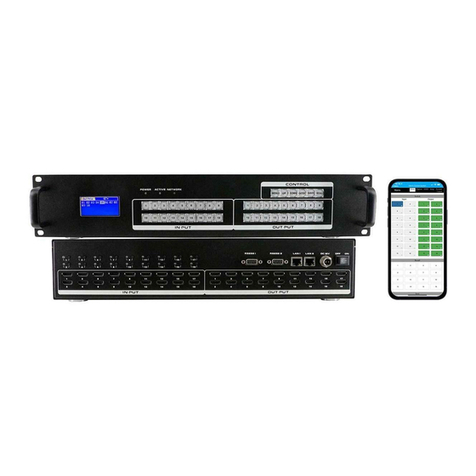
HDTV Supply
HDTV Supply FIX1818E User manual

HDTV Supply
HDTV Supply HDM-B44C User manual

HDTV Supply
HDTV Supply HDTVMT0404140 User manual
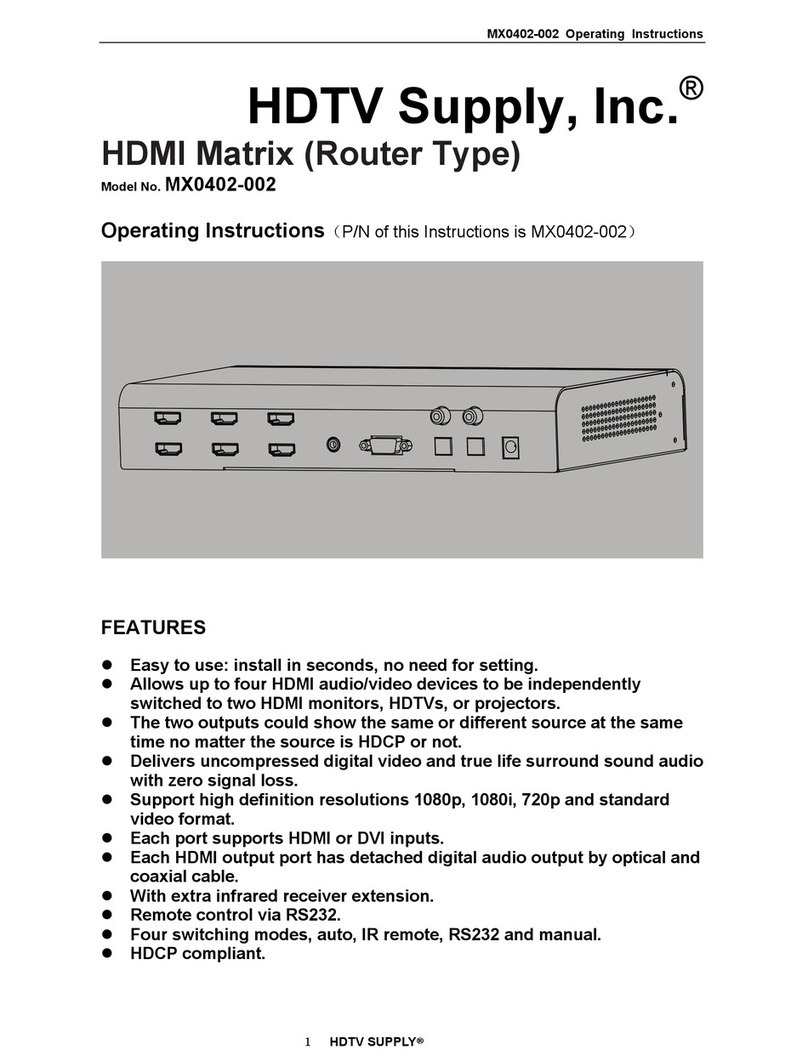
HDTV Supply
HDTV Supply MX0402-002 User manual

HDTV Supply
HDTV Supply MX04HE1 User manual

HDTV Supply
HDTV Supply HDTVHDM942U User manual
